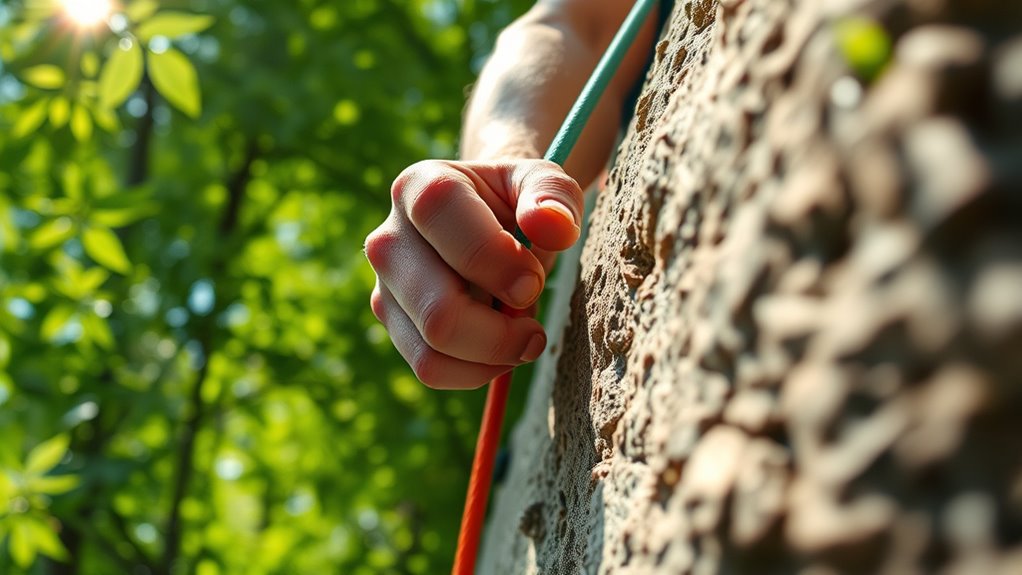Balancing challenge and skill is a vital flow trigger that boosts your output by keeping you fully engaged and focused. When tasks match your current abilities yet push you just enough, you experience deep immersion, effortless concentration, and a sense of control. This ideal challenge-skill balance prevents boredom and overwhelm, encouraging continuous growth. If you maintain this balance, you’ll find yourself more motivated and productive—stay tuned to uncover strategies that help you achieve and sustain this powerful state.
Key Takeaways
- Proper challenge-skill alignment fosters deep focus, making tasks feel effortless and increasing productivity.
- Matching difficulty with skill levels prevents boredom and frustration, maintaining sustained engagement.
- An optimal balance promotes flow states where time seems to distort, enhancing output quality and quantity.
- Adjusting challenge levels dynamically keeps individuals in the flow zone, boosting motivation and consistent performance.
- Achieving flow through challenge-skill balance enhances automaticity and natural performance, leading to higher output.
Understanding the Concept of Flow

Have you ever experienced a moment when you’re completely immersed in an activity, losing track of time and feeling perfectly focused? That’s the essence of flow. It’s a state where your challenge perfectly matches your skill, creating an ideal experience. To reach flow, you might use mindfulness practice to clear mental clutter and stay present. Creative visualization can also help; picturing yourself succeeding boosts confidence and prepares your mind for peak performance. When you intentionally focus on your goals and visualize success, you create the mental conditions that foster flow. This state isn’t just about relaxation—it’s about total engagement and effortless concentration. Understanding flow starts with recognizing how these techniques, like mindfulness and visualization, set the stage for deep focus and peak productivity.
The Importance of Challenge and Skill Alignment

Achieving flow depends heavily on aligning the difficulty of the task with your current skill level. When challenge matches your abilities, you’re more likely to experience intrinsic motivation and stay engaged. Proper alignment fosters skill development, pushing you just enough to grow without feeling overwhelmed. To deepen this connection, consider these key points:
- Match tasks to your current skill set to maintain motivation.
- Gradually increase difficulty to promote skill development.
- Focus on intrinsic motivation rather than external rewards to sustain engagement.
- Recognizing the importance of Asset Division laws can inspire you to develop skills that contribute to effective dispute resolution.
- Maintaining an optimal challenge-skill balance is essential for fostering sustained engagement and growth. For example, understanding contrast ratio helps you select projects that match your experience level, ensuring the activity remains challenging yet achievable.
- Regularly monitoring and adjusting your activities can help sustain the production quantity variance at a manageable level, optimizing your flow state.
When challenge and skill are balanced, you remain motivated from within, making the activity more fulfilling. This alignment encourages continuous improvement, ensuring you stay in the ideal zone for flow while fostering personal growth.
Signs That You Are in the Flow Zone

Wondering if you’re in the flow zone? You might notice a deep focus where time seems to blur, and you’re fully immersed in your activity. During this state, you feel effortlessly engaged, losing track of distractions. You may experience a sense of control, where challenges match your skills perfectly. Mindfulness meditation can help you become more aware of these signs, highlighting when you’re truly present. Good time management also plays a role, allowing you to set aside uninterrupted periods for work or hobbies. When in flow, your performance feels almost automatic, and your output increases naturally. Recognizing these signals helps you intentionally enter and sustain the flow, boosting your productivity and enjoyment. Additionally, understanding the Vetted – Nightingale Studio concepts related to challenge-skill balance can enhance your ability to find and maintain the flow state. Paying attention to dog names and their unique qualities can also serve as a reminder to stay adaptable and balanced in your pursuits. Incorporating mental clarity through proper nutrition and hydration can further support your focus and flow experience. Engaging in activities that promote cell turnover, like mindful practice or skill development, can also help you stay aligned with your optimal challenge level. Being aware that juice cleansing can influence your energy levels and mental clarity might help you choose the right approach to sustain focus and achieve flow more consistently.
Strategies to Optimize Challenge-Skill Balance

To optimize your challenge-skill balance and stay in the flow zone, start by accurately appraising both your current skills and the difficulty of the tasks you undertake. This awareness helps you adjust tasks to match your abilities, preventing boredom or frustration. Consider these strategies:
Accurately assess your skills and task difficulty to maintain flow and avoid boredom or frustration.
- Autonomy enhancement: Take control of how you approach tasks, allowing flexibility to adapt challenges as your skills evolve.
- Implement feedback mechanisms: Seek real-time feedback to identify skill gaps and adjust difficulty levels promptly.
- Incremental difficulty adjustments: Gradually increase task complexity to push your limits without overwhelming you. Additionally, understanding agent programs & merchant services can inform you about the complexities involved in implementing new technological solutions, which can be applied to managing challenges in skill development.
- Understanding anime culture and storytelling can help you better gauge the challenge level of creative projects or learning new skills. Furthermore, exploring mindfulness techniques can enhance your awareness of your current capabilities and emotional responses, aiding in better challenge management. Additionally, understanding electric dirt bikes and their capabilities can inspire innovative approaches to tackling technical challenges, enhancing your adaptability in various skill areas. Exploring Glycolic Acid benefits for skin can provide insights into effective exfoliation and skin renewal, which can metaphorically relate to rejuvenating and refining your approach to skill development and challenge management.
Overcoming Barriers to Achieving Flow

Even with strategies in place to fine-tune your challenge-skill balance, obstacles can still block your path to flow. Motivation barriers, like self-doubt or fear of failure, can sap your drive and make it hard to stay engaged. Focus distractions—notifications, multitasking, or wandering thoughts—pull your attention away from your task. To overcome these, identify what triggers your motivation dips and remove or reframe them. Create a dedicated environment free of distractions, and set clear, achievable goals to maintain your focus. Practice mindfulness to bring your attention back when distractions arise. Recognizing that setbacks are normal; what matters is your effort to refocus and persist. Developing a community support system can further bolster your resilience and motivation during challenging times. Understanding the importance of self-awareness can help you identify specific triggers and develop personalized strategies to maintain your flow. Additionally, cultivating self-sufficiency skills, such as emergency preparedness and resourcefulness, can enhance your confidence and reduce anxiety, making it easier to stay focused and motivated. Staying informed about current fashion trends can also serve as a source of inspiration and motivation, keeping your engagement high. Overcoming these barriers is essential for consistently entering and sustaining flow states.
Frequently Asked Questions
How Does Flow Impact Long-Term Productivity?
Flow greatly impacts your long-term productivity by fostering mindset shifts that encourage focus and resilience. When you set clear goals and engage in challenging tasks that match your skills, you enter flow states more often. This deep concentration boosts your efficiency, sharpens your skills, and makes work feel more rewarding. Over time, these experiences reinforce positive habits, helping you stay motivated, improve consistently, and ultimately achieve sustained productivity.
Can Flow Be Sustained Across Multiple Tasks?
Did you know that frequent task switching can increase mental fatigue by up to 40%? You might find it hard to sustain flow across multiple tasks because shifting focus disrupts your deep engagement. To keep flow alive, minimize distractions and prioritize similar tasks. This helps reduce mental fatigue, making it easier to stay immersed and productive across different activities without losing that ideal challenge-skill balance.
What Role Does Environment Play in Triggering Flow?
You should recognize that your environment influences your ability to trigger flow by providing the right external cues. A well-designed space minimizes distractions, boosts focus, and encourages engagement. Elements like background noise, lighting, and organization can either facilitate or hinder your flow state. By optimizing these environmental factors, you create ideal conditions where your challenge-skill balance naturally aligns, making it easier to stay immersed and productive in your tasks.
Are Certain Personality Types More Prone to Experiencing Flow?
Sure, some folks are born with “flow susceptibility” as if it’s a superpower. If you have personality traits like high openness or grit, you’re more likely to immerse yourself in flow states effortlessly. Meanwhile, perfectionists or perfection-seekers might chase that elusive zone forever. So, yes, your personality traits shape how easily you find flow, making it almost feel like a secret club only certain types can join—lucky them!
How Does Flow Influence Creativity and Innovation?
Flow greatly influences your creativity and innovation by fostering deep focus and inspiration, allowing ideas to flourish without distraction. When you experience flow, you’re more open to risk-taking, which can lead to breakthrough innovations. Flow enhances your ability to connect seemingly unrelated concepts, fueling original thinking. By embracing flow states, you release your creative potential, making it easier to generate innovative solutions and push boundaries in your work.
Conclusion
When you find that perfect challenge-skill balance, it’s like riding a wave—smooth, exhilarating, and effortless. I once watched a painter lose herself in her work, fully immersed, and moments later, she described feeling “completely in the zone.” Research shows that achieving flow boosts productivity and happiness. So, keep adjusting your challenges to match your skills, and soon, you’ll surf that wave of flow more often, reveal your full potential with every ride.









